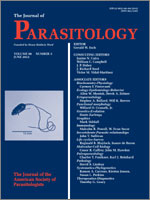We assessed how spatial and temporal heterogeneity and competition structure larval trematode communities in the pulmonate snail Lymnaea stagnalis. To postulate a dominance hierarchy, mark-release-recapture was used to monitor replacements of trematode species within snails over time. In addition, we sampled the trematode community in snails in different ponds in 3 consecutive years. A total of 7,623 snails (10,382 capture events) was sampled in 7 fishponds in the Jindřichův Hradec and Třeboň areas in South Bohemia (Czech Republic) from August 2006 to October 2008. Overall, 39% of snails were infected by a community of 14 trematode species; 7% of snails were infected with more than 1 trematode species (constituting 16 double- and 4 triple-species combinations). Results of the null-model analyses suggested that spatial heterogeneity in recruitment among ponds isolated trematode species from each other, whereas seasonal pulses in recruitment increased species interactions in some ponds. Competitive exclusion among trematodes led to a rarity of multiple infections compared to null-model expectations. Competitive relationships among trematode species were hypothesized as a dominance hierarchy based on direct evidence of replacement and invasion and on indirect evidence. Seven top dominant species with putatively similar competitive abilities (6 rediae and 1 sporocyst species) reduced the prevalence of the other trematode species developing in sporocysts only.
How to translate text using browser tools
1 June 2012
The Role of Spatial and Temporal Heterogeneity and Competition In Structuring Trematode Communities In the Great Pond Snail, Lymnaea stagnalis (L.)
Miroslava Soldánová,
Armand M. Kuris,
Tomáš Scholz,
Kevin D. Lafferty
ACCESS THE FULL ARTICLE

Journal of Parasitology
Vol. 98 • No. 3
June 2012
Vol. 98 • No. 3
June 2012




